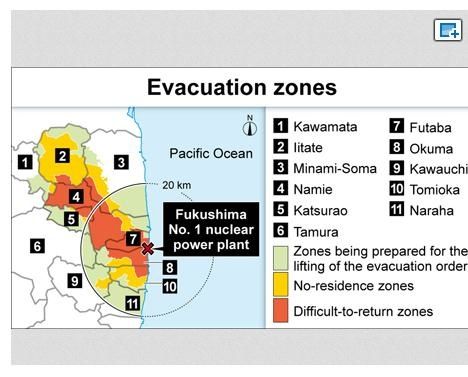(Source)
http://fukushima-is-still-news.over-blog.com/
November 15, 2013
EDITOIAL:
Opinions of Fukushima evacuees essential in support measures
http://ajw.asahi.com/article/views/editorial/AJ201311150065

It
will also re-examine safety standards of radiation doses used for
decontamination work and health-care measures.
The
evacuees still have a common wish--the situation will return to the
way it was before the nuclear accident. But over the last two years
and eight months, they have realized that this wish will not come
true.
Naturally,
many have decided to make a fresh start in other places.
HOW
TO MAINTAIN FAIRNESS
We
have no objection to the government broadening the options for
support. But in deciding its policies, the government must ensure
that it does not create new rifts among residents.
Regardless
of whether the evacuees decide to return home or not, the only thing
the government can do is to carefully deal with each case based on
the idea of helping individuals rebuild their lives.
In
Namie, Fukushima Prefecture, where all 20,000 residents were required
to evacuate, communities were split into three categories.
The
most heavily contaminated areas are designated as
“difficult-to-return zones,” and there are currently no prospects
for residents to return there. “No-residence zones” are places
where several more years are needed to reduce radiation levels.
The
remaining areas, where residents are expected to be able to return in
a relatively short period, are designated as “zones being prepared
for the lifting of the evacuation order.”
The
difficult-to-return zones account for 80 percent of the town’s
area. In number, it equals about half that of the populations in each
of the other two zones.
“In
the towns of Okuma and Futaba, where 90 percent of the population
comes from difficult-to-return zones, and Naraha, which has no such
zones, it is easier for the municipal governments to come up with
requests and reconstruction plans,” a Namie town official said.
“But in Namie, the gaps in the circumstances among affected
residents are too wide.”
One
such gap exists in financial support for evacuees to acquire new
homes for relocation.
The ruling parties came up with a proposal to provide additional support directed at residents of difficult-to-return zones.
But
outside the designated areas, many homes remain difficult to return
to due to leaking roofs and rat infestations. If the provision of
support is narrowed, these households would be left out.
Funding
remains a concern. Homes washed away by the March 11, 2011, tsunami
would be outside the scope of compensation if the funding is provided
through additional compensation measures by Tokyo Electric Power Co.,
operator of the crippled nuclear power plant.
That
could lead to a wider gap between those who lost their homes and
those whose homes remain standing.
The circumstances of each community must be taken into account to maintain fairness.
It
would be meaningless for “the central government to come to the
fore” if it imposes too many restrictions on how and when to spend
the money provided to local governments of stricken areas. Measures,
such as setting up funds and granting lump-sum subsidies, are needed
to make it easier for those local governments to exercise discretion
in spending their budgets to meet the actual circumstances.
HEALTH-CARE
SUPPORT AS A SET
It
is also important to prevent changes in safety standards of radiation
exposure from leading to the abandonment of stricken areas.
A
panel of the Nuclear Regulation Authority put together a set of
proposals comprising three major points: Standards for
decontamination can be relaxed, maintaining the long-term goal of
reducing additional radiation exposure in affected areas to 1
millisievert a year; evacuees should be allowed to return home if
annual radiation doses are below 20 millisieverts; and levels should
be calculated based on readings on individual dosimeters instead of
air dose measurements.
Radiation
levels of decontaminated areas have declined since the time
immediately after the accident. However, it has been difficult to
lower annual radiation doses to 1 millisievert or less in many areas.
Although
Date, Fukushima Prefecture, is located outside the evacuation zone,
it was one of the first municipalities to tackle decontamination
work.
Takahiro
Hanzawa, the city official in charge of decontamination, said, "We
should stop decontamination work when we can not expect the radiation
levels to decline any more. It leads to the destruction of nature and
could exhaust funding for other necessary policies.”
If
the government sticks to the 1-millisievert goal, resulting in a
delay in rebuilding livelihoods, re-examining the standards with the
consent of residents could be an option.
However,
decontamination work has yet to start in heavily polluted areas.
Concerns
have been raised that eased standards could lead to reduced measures
in dealing with radiation exposure and helping evacuees return to
their homes.
Regarding
the shift in measuring radiation doses, it will be difficult to
gather the necessary data unless a system is established for
individual residents to keep measuring and recording readings on
their dosimeters.
The
shift in policy should be presented as a set with long-term
health-care support measures, including the assignment of public
health nurses and counselors and deciding how to respond when
radiation doses surpass permissible levels.
PARTICIPATION
OF RESIDENTS
When
we consider the serious damage caused by the nuclear disaster, it
is difficult to provide a solution that can satisfy everyone.
Under
such circumstances, it
is important to include residents in discussions so that they may
find it easier to accept the agreed-upon measures for their futures.
The
small gatherings of residents that allow participants to freely
exchange views should continue. Such steady efforts are common in
cases in which reconstruction plans and decontamination work have
made smooth progress.
Encouraging
local communities to develop the power of autonomy will help them
overcome difficult times when no solution can satisfy all.
No comments:
Post a Comment